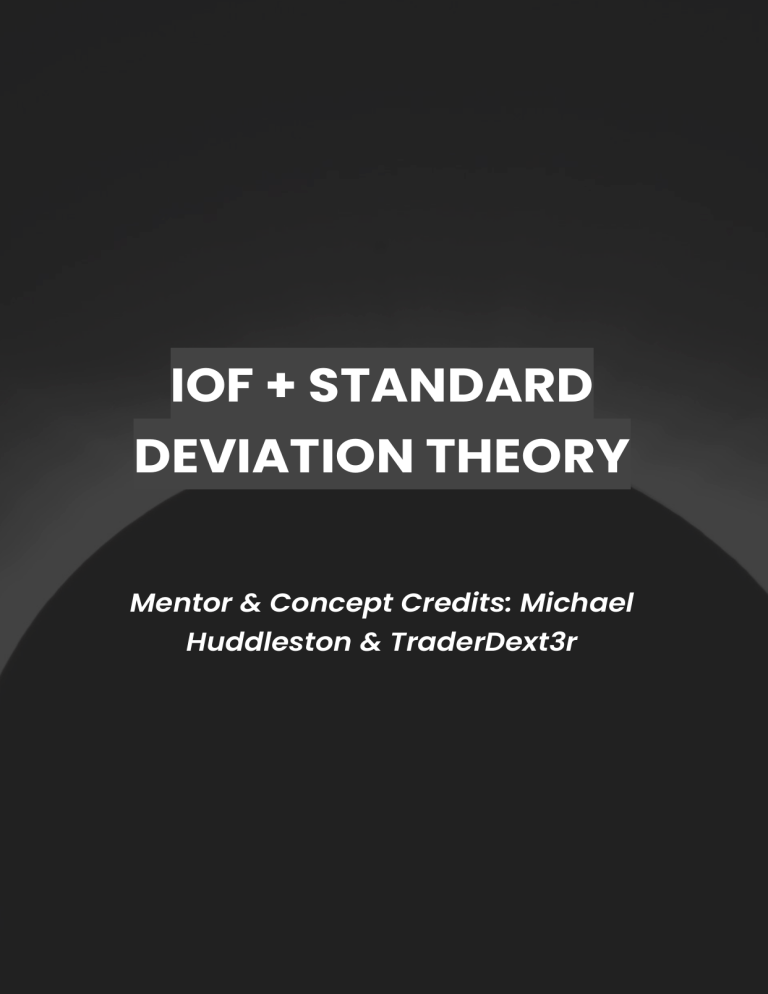
IOF + STANDARD DEVIATION THEORY Mentor & Concept Credits: Michael Huddleston & TraderDext3r DISCLAIMER: The information provided in this trading PDF/document is for educational and informational purposes only. It does not constitute financial advice, and no content within this document should be considered as a recommendation or endorsement to engage in any specific trading or investment activity. Trading in financial markets involves risk, and individuals should conduct their own research and seek professional advice before making any investment decisions. The author of this PDF/document does not assume any responsibility for the accuracy, completeness, or relevance of the information provided. All readers are encouraged to consult with a qualified financial advisor or professional before making any financial decisions. Any actions taken based on the information in this PDF/document are at the sole discretion and risk of the reader. By accessing this PDF/document, you acknowledge and agree that the author, publisher, and distributors are not responsible for any losses or damages that may occur as a result of the use of the information presented in this document. The content is provided "as is" without any warranties, expressed or implied. The content of this document may not be accurate, up-to-date, or applicable to individual circumstances. It is advisable to verify any information and seek professional advice before making financial decisions. TABLE OF CONTENTS DISCLAIMER: 2 TABLE OF CONTENTS 3 Introduction 4 Institutional Order Flow (IOF) 5 Interbank Price Delivery Algorithm 6 Examples 7 Examples Cont. 8 Trade Breakdown: A Full Step by Step Guide 8 Trade Breakdown: Weekly Timeframe 9 Trade Breakdown: Daily Timeframe 10 Trade Breakdown: Standard Deviations + PO3 11 Trade Breakdown: Standard Deviation Cont. 12 Introduction Hello, welcome to the second instalment of Standard Deviation Theory. This pdf will be an in-depth guide to Institutional Order Flow (IOF) + Standard Deviation Theory. If you haven’t already, I recommend reading the previous PDF: ‘Standard Deviation + PO3’. These concepts were initially outlined/discovered by ICT (Michael Huddleston) however have been taken further with the independent research of TraderDext3r (MonsterLab). Please watch MonsterLab’s IOF + STDV Youtube Video with this PDF to further your studies. TraderDext3r - MonsterLab Founder 🧪 ICT Charter / 4.5 Years Experience STDV Theory Before we dive into the concepts I need to give full credit to Dexter, please see the QR Code for all the links to his social media. Be sure to follow, subscribe and study his content. Who am I? - po3trader Day trader of Indices & Forex markets 6 years trading experience Primarily trades PO3 during NY AM session Pairs I trade: NAS, SPX & GU Entry Model: 4H PO3 + STDv Student of ICT / MonsterLab Trader 🧪 Institutional Order Flow (IOF) What is IOF? The Directional movement of Price to seek Liquidity to the Upside or the Downside. - Where did Price come from? - Where is Price now? - Where is Price likely to go? The Market Efficiency Paradigm - Change your perspective The Market Efficiency Paradigm is a representation of how Smart Money (large banks & institutions) interprets price & influences uninformed money (retail). Retail believe that their actions of buying/selling pressure move the market because of their sheer numbers. (depicted as the large circle in the diagram) However it is the Smart Money who are the real influencers of price, they seek and draw price to the Liquidity. Think like Smart Money. Interbank Price Delivery Algorithm Also known as the ‘Algo’ is the AI that delivers price. It is designed to deliver price as efficiently as possible. How does it do it? IPDA will be drawn to Liquidity in the form of SSL & BSL (Old Highs & Lows) or Inefficiencies/Imbalances (FVG/LV etc). Why is it important? Market Efficiency Paradigm & IPDA are key to understanding Institutional Order Flow. You want to establish bias? This is how… To simplify even further, price only does two things: Moves from Internal Range Liquidity > External Range Liquidity. Moves from External Range Liquidity > Internal Range Liquidity. When Internal Range Liquidity is taken, External Range Liquidity becomes the draw. When External Range Liquidity is taken, Internal Range Liquidity becomes the draw. IRL = Internal Range Liquidity ERL = External Range Liquidity Where did price come from? IRL (SIBI + LV) Where is it now? ERL (Old Low) Where is price likely to go? Back to IRL: - Our draw is Internal (back into the Dealing Range) so our bias is Bullish unless price says otherwise. Examples We marked out our current Dealing Range with Premium & Discount. I selected 2 FVGs (IRL) within a Premium (above Equilibrium). Now we ask those same 3 questions: Where did Price come from? ERL (Old Low) Where is Price now? IRL (FVG) Where is Price likely to go? Back to External Range Liquidity (Relative Equal Lows) Our bias would switch to Bearish: ERL taken, price has moved from a Premium back down to a Discount. Where do we look next? We are at ERL so now we look back to IRL. Examples Cont. Last example, IRL taken > ERL. We could do this all day so I hope you now have a greater understanding of how to determine bias. Remember price is fractal so this applies to any timeframe. Trade Breakdown: A Full Step by Step Guide Now is the time to watch the IOF + STDV video on MonsterLab’s Youtube and refer to these notes. We are just applying the process. Case study: S&P 500 E-mini Futures Starting on the Monthly Timeframe: ERL taken, look Internally to IRL BISI. Our draw on Liquidity is the BISI = We have a Bearish Bias. This is our Long Term Bias. Trade Breakdown: Weekly Timeframe Scaling down to the Weekly Chart we can deploy the same process to find a Shorter Term Draw that is closer to price. Same process, ERL High taken > Look Internally to the Weekly BISI. Institutional Order Flow is clearly Bearish. Trade Breakdown: Daily Timeframe Now you will start to see clear Order Flow. You will see Bearish PD Arrays being respected & Bullish PD Arrays being disrespected. Look for -Orderblocks (last up-candles) to create ‘Resistance’ for new Selling. We have clearly identified the Institutional Order Flow and now is the time to drop to the Lower Timeframes to look for Structure, Standard Deviations and look for PD Arrays. Note: Institutional Order Flow comes first. No narrative, no trade. Trade Breakdown: Standard Deviations + PO3 This process is the same as outlined in the first PDF, whatever discipline you chose to trade, it is the same. Using the 8H Timeframe we are looking at the 3M PO3 in development: The large candle to the right of the price action represents the 3 Month Candle. The Accumulation & Manipulation phase have been completed, and we are now anticipating the Distribution phase. Price is inside the Silver Bullet Zone (1-1.5 STDV) of the Distribution Phase. IOF = Bearish so price should disrespect all Bullish PD Arrays. When price breaks through the Bullish FVG we have a new Support Natural or Inversion FVG to take Shorts from & target the 2-2.5 STDV in line with the HTF PO3. Note: Any IRL within 1-1.5 STDV is a potential Entry point. Trade Breakdown: Standard Deviation Cont. This is the Standard Deviation in confluence with HTF Institutional Order Flow, 3 Month PO3 in development: You can see how we can combine Institutional Order Flow to build narrative and give us a Directional Bias, with this bias we can use Standard Deviations and take advantage of any PO3 of your preference/discipline and use HTF Draws on Liquidity as targets. This was an example of a HTF PO3 Case Study but it is not limited to this, please reference the first PDF. These same principles can be applied to LTF PO3 to scale into entries. Thank for reading 🧪 -po3trader




